Head To Head: Apple iPhone 5 Vs. Samsung Galaxy S III
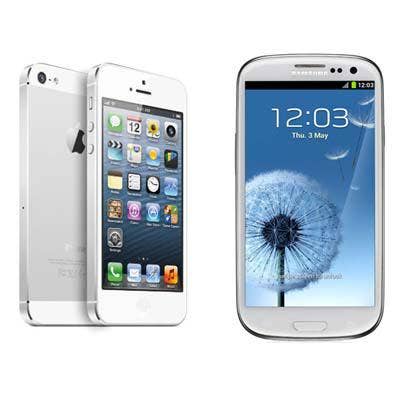
Fight Of The Century
For the smartphone world, this is Ali versus Frazier. There's simply no other way to define the battle between the Apple iPhone 5 and the Samsung Galaxy S III. Between the legal wrangling, clever satirical attack ads and raw, heated competition on the open market, Apple and Samsung are the clear winners of the smartphone hardware race. It doesn't even matter that their two devices aren't the most high-powered, fully-featured or largest on the market. Other manufacturers must make these hyperbolic claims just to grab the last gasps of oxygen Apple and Samsung have left in the room.
Yes, this is sure to be the knock-down, drag-out battle between the titans: Two gizmos enter, but only one gizmo leaves (the store, with you).
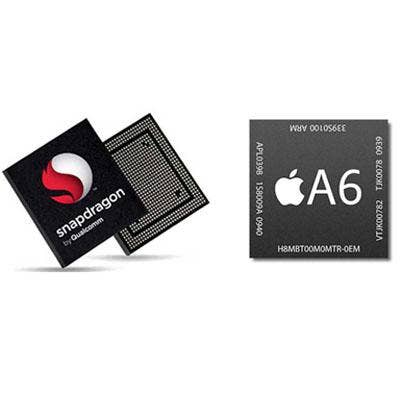
The Internals
The international variant of the GSIII has a quad-core Exynos chip made in-house at Samsung. But in America, we're treated differently. Namely, U.S. variants see an LTE radio added and the Exynos taken away, replaced by a dual-core Qualcomm Snapdragon S4 clocked at 1.5GHz. Two GB of RAM support the phone, and 16 GB of internal storage will hold more than a few tunes, photos and videos. There's also a slot for microSD storage expansion.
The iPhone 5 packs the same internals (besides antenna frequencies) regardless of the country of destination. The processor is Apple's A6 dual-core SoC clocked at 1.3GHz. While that's slower than the GSIII, it's important to remember that Apple hardware and software are developed together, so Apple's hardware is usually much more efficient than the competition. Graphics are handled by a tri-core PowerVR SGX543MP4 (catchy, huh?). One GB of RAM rounds out the iPhone 5's kit. The iPhone 5 comes in fixed-storage variants of 16 GB, 32 GB and 64 GB, with each storage tier adding $100 to the phone's price.
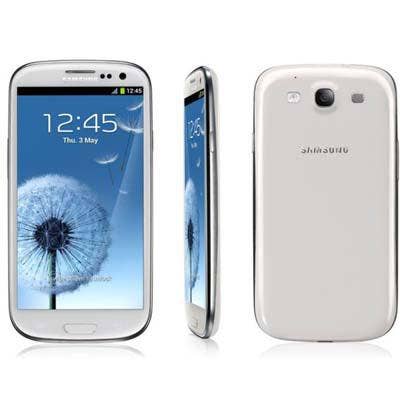
Display
Here comes the hyperbole. The Galaxy S III's screen is called the HD Super AMOLED. It measures 4.8-inches and has a resolution of 1,280 x 720. You know, fairly close to the resolution of a run-of-the-mill laptop panel. The pixels per inch (ppi) registers at 306. This panel is a PenTile display, meaning that the traditional RGB (red-green-blue) color pattern is supplanted by a RGBG pattern, which boosts its resolution but lends it a greenish hue. It's a trade-off worth taking into account.
The iPhone 5 comes to market with its first-ever screen size upgrade. The now 4-inch Retina Display has seen its resolution bumped to 1,136 x 640, retaining the same impressive 326 ppi as the iPhone 4S. Apple also improved the color saturation on its LCD panel. The glass itself is much thinner than before, allowing for the svelte build of the new device.
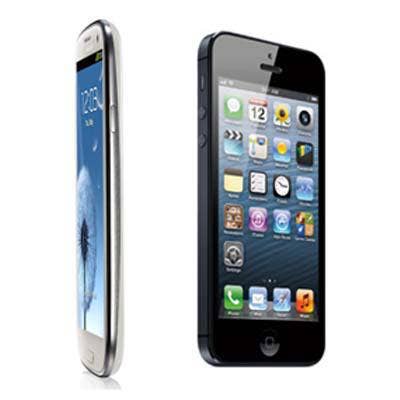
Tale Of The Tape
On the subject of svelte, these two are among the svelte-ist. Built of polycarbonate plastic, the GSIII is 5.4 inches long, 2.8 inches wide and a third of an inch thick. It had to be a big device to handle the nearly 5-inch display, but Samsung managed to keep the weight down to just 4.7 ounces. The polycarbonate shell certainly helps, but a plastic case doesn't inspire confidence in terms of drop protection.
Apple's device is smaller, lighter and made of more reassuring ceramic and aluminum. It measures 4.9 inches long, 2.3 inches wide and 0.30 inches thick. It weighs in at a bantam 3.95 ounces. It is, in fact, 0.04 inches thinner than the GSIII, but that must be balanced against a screen-size advantage for Samsung of nearly an inch.
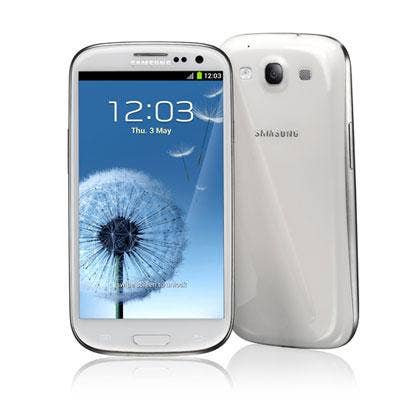
Bells And Whistles
Both phones have LTE, and both phones have all the GPS chips, gyros, accelerometers, spare cameras and compasses that you could ask for. As for extras, there are a few key differences between the two. Only the GSIII is expandable, and only the GSIII is available on T-Mobile, the nation's fourth-largest carrier (Apple and Samsung phones also are available on AT&T, Sprint and Verizon). What's more, only Samsung delivers NFC, making possible the scenario in this cheeky Galaxy S III ad.
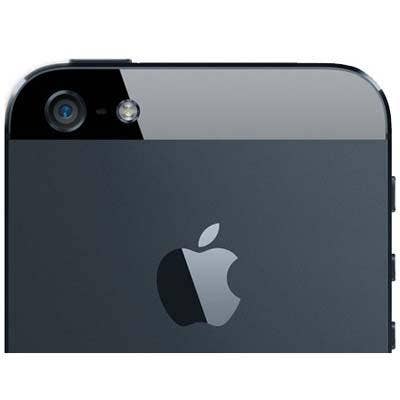
Camera
The GSIII's 8MP shooter is packed to the gills with features. Samsung adjusted the software to eliminate shutter lag and brought great features like burst mode (which takes a rapid set of photos) to the fore. It records video in 1,080p. The thing is, the iPhone 5's camera packs nearly all of these features too (it lacks burst mode in its standard software.) Both phones also pack in 1,080p video recording.
While there is basic feature parity between the two cameras, most outlets give a slight edge to the iPhone 5's camera for better low-light performance and better panoramic photo stitching. But, there is a bright spot for Samsung here; the GSIII's front-facing camera checks in at 1.9MP compared with the iPhone 5's 1.2MP sensor.
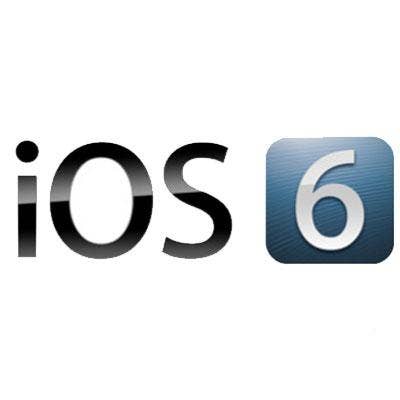
Software
Android has come a long way, and Samsung has added a number of features to the Galaxy S III to help it along. There's the gimmicky S Voice for speaking commands, the useful S Beam for document sharing and the downright creepy Smart Stay, which uses the phone's front-facing camera to track your eyes and decide whether to keep the screen on. Android's app ecosystem, Google Play, has exploded in popularity and makes finding apps easy. Apple's App Store has far more apps, but they're sometimes hard to put your finger on.
In the corner opposite Android is iOS. It's stable. It's intuitive. It works seamlessly with the desktop and the enterprise. Love or hate it, you have to respect its functionality, slick integration with social networks and enormous app store ecosystem -- probably the best out there. iOS continues to push the limits of what smartphones are capable of. And, iOS came first.
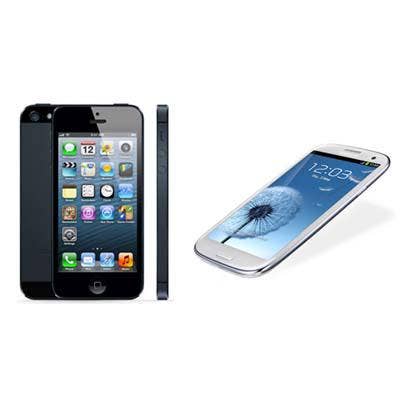
The Bottom Line
One of the problems with being a leader is that competition is constantly trying to knock you down. For awhile, the market was simply trying to catch Apple, which continues to enjoy a commanding lead in the sheer number of available iOS apps. But in late 2010, sales of Android-based phones surpassed that of iPhones, according to Gartner, and IDC predicts the trend to continue through 2016.
Also, in the third quarter, Samsung widened its lead on Apple in worldwide smartphone sales, and sales of the GSIII reportedly surpassed those of iPhone in the same period, according to Strategy Analytics.
However, the iPhone 5 is Apple's best iPhone ever. The new design is gorgeous and not as prone to shattering. The screen is bigger (finally) and retains its clarity. LTE has been added to the mix, and the App Store keeps the hits coming. The smartphone market is an incredibly competitive place these days. Devices like these make the choice tough for anyone, except those on T-Mobile.